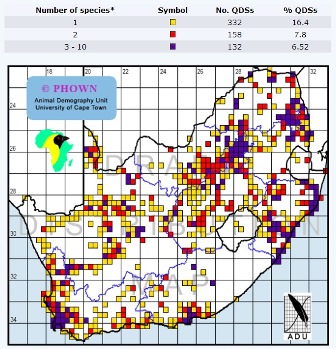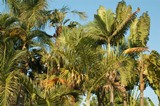PHOWN (PHOtos of Weaver Nests) gaps
 PHOWN (PHOtos of Weaver Nests) is a citizen science monitoring project aimed at determining the distribution of colonies or nests of all weaver species globally, and studying the variation in their colony sizes. Counting weaver nests and taking photos allows tracking of changes in weaver breeding effort. This project provides an easy way of monitoring common weavers, while helping the conservation of threatened weavers. Download PHOWN flyer here. To take part, read here.
PHOWN (PHOtos of Weaver Nests) is a citizen science monitoring project aimed at determining the distribution of colonies or nests of all weaver species globally, and studying the variation in their colony sizes. Counting weaver nests and taking photos allows tracking of changes in weaver breeding effort. This project provides an easy way of monitoring common weavers, while helping the conservation of threatened weavers. Download PHOWN flyer here. To take part, read here.
Gaps in the PHOWN database
There are lots of records in the PHOWN database but there are also gaps that you can help to fill!Some gaps in the PHOWN database:
- The closest weaver colony to you! And even if you have submitted it already, you can submit repeat records.
- There are several species with no PHOWN records - see list below.
- There are several countries (within the range of weavers) with no PHOWN records - see global map here and zoom in to a country to see its PHOWN records.
Species with no PHOWN records
Click on the species number to see a species summary.Note: the nest of the following weaver species have not been described at all yet: Bates's Weaver, Golden-naped Weaver, and Yellow-legged Weaver (also the nest of the Forest Fody has not been formally described but is known to be similar to that of the Madagascar Fody).
The most recently described weaver nests are:
Clarke's Weaver - 2013 - news items.
Black-chinned Weaver - 2013 - news items.
| 3716 | Bob-tailed Weaver | Brachycope anomala |
| 3746 | Fire-fronted Bishop | Euplectes diadematus |
| 971 | Marsh Widowbird | Euplectes hartlaubi |
| 3752 | Jackson's Widowbird | Euplectes jacksoni |
| 3756 | Mountain Marsh Widowbird | Euplectes psammocromius |
| 14214 | Weaver family | FAMILY Ploceidae |
| 1069 | Comoro Fody | Foudia eminentissima |
| 3764 | Forest Fody | Foudia omissa |
| 3794 | Gola Malimbe | Malimbus ballmanni |
| 3796 | Cassin's Malimbe | Malimbus cassini |
| 3800 | Red-bellied Malimbe | Malimbus erythrogaster |
| 3808 | Rachel's Malimbe | Malimbus racheliae |
| 3884 | Maxwell's Black Weaver | Ploceus albinucha |
| 3890 | Golden-naped Weaver | Ploceus aureonucha |
| 3896 | Bates's Weaver | Ploceus batesi |
| 4183 | Black-throated Weaver | Ploceus benghalensis |
| 3908 | Yellow-capped Weaver | Ploceus dorsomaculatus |
| 3792 | Yellow-legged Weaver | Ploceus flavipes |
| 1149 | Giant Weaver | Ploceus grandis |
| 3920 | Streaked Weaver | Ploceus manyar |
| 4185 | Finn's Weaver | Ploceus megarhynchus |
| 3930 | Preuss's Weaver | Ploceus preussi |
| 3936 | Fox's Weaver | Ploceus spekeoides |










